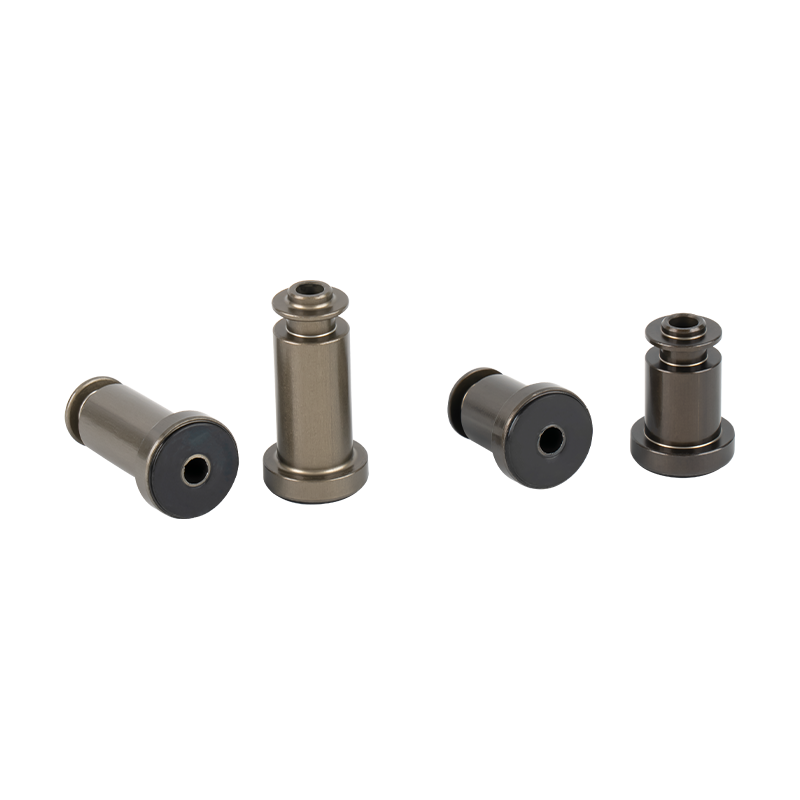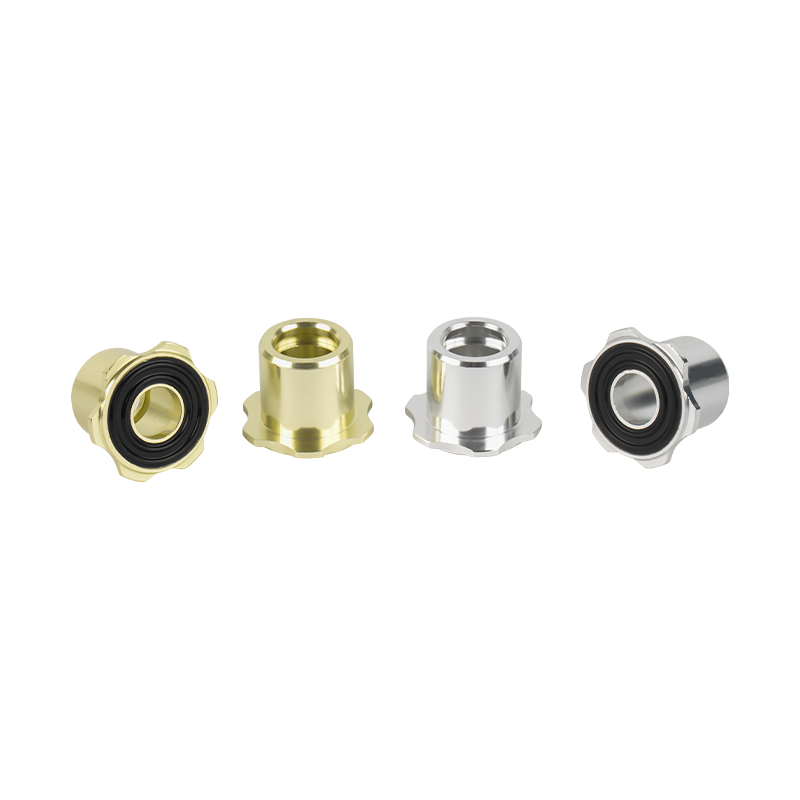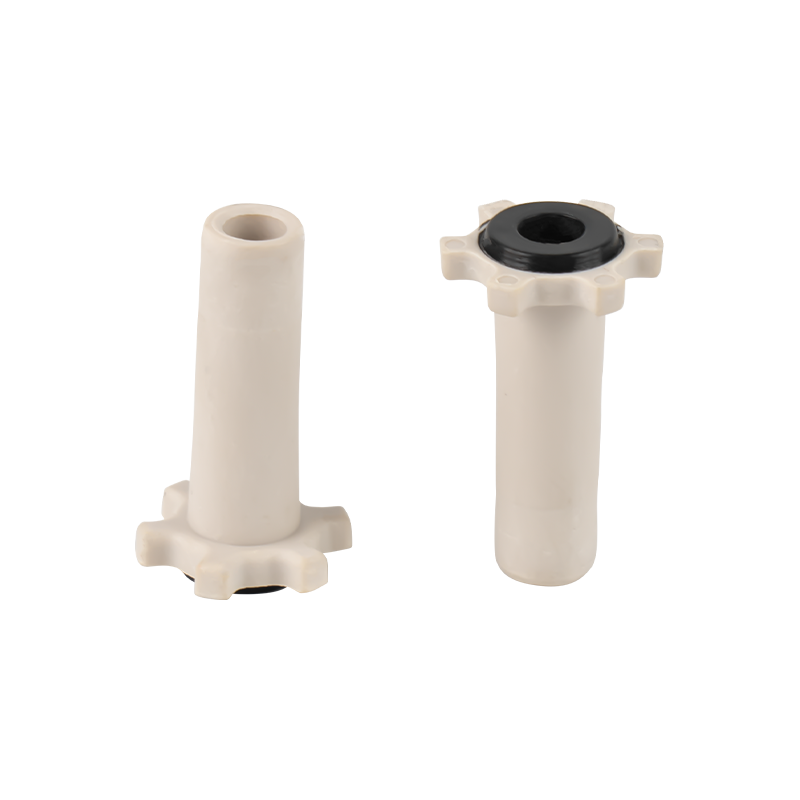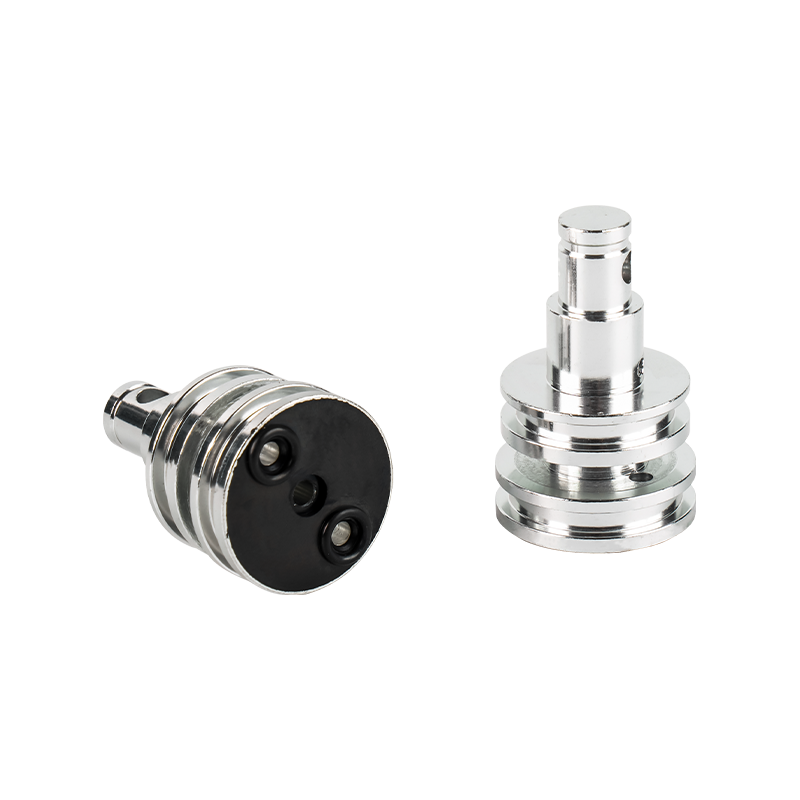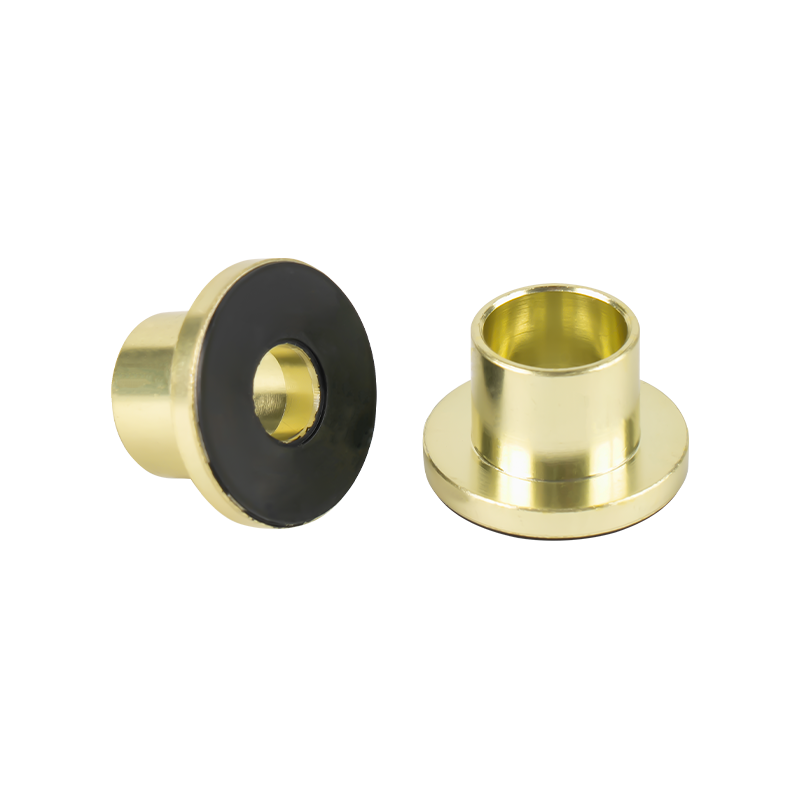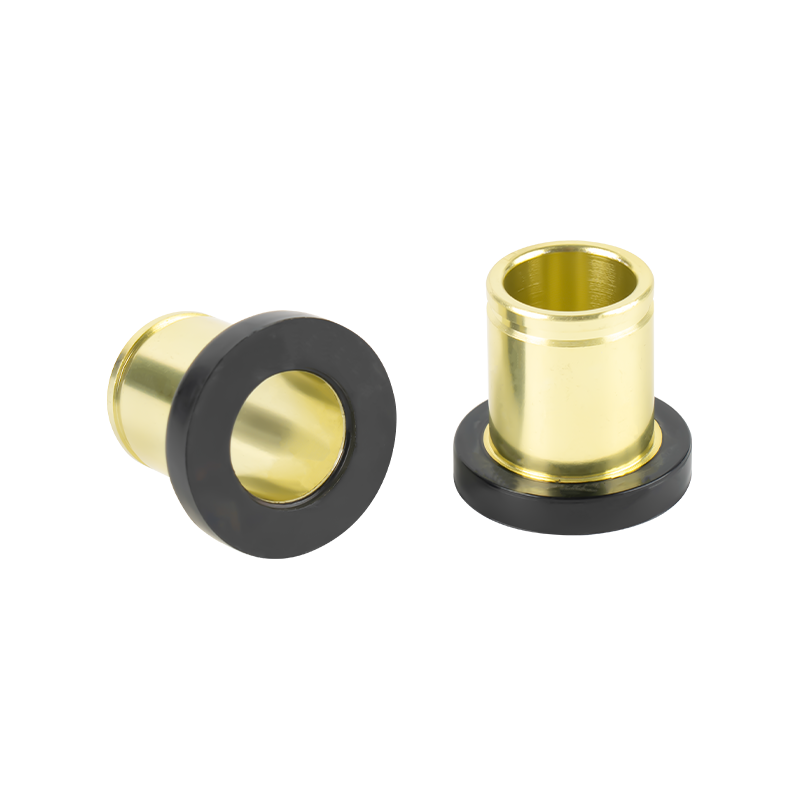Rubber Parts: The "Elastic Cornerstone" in Industry and Daily Life
2025-08-14
Content
- 1 Versatile Functions: An "All-Rounder" in Multiple Fields
- 2 Sealing Function: A "Fluid Barrier" from Micro-Nano Gaps to Ultra-High Pressure Environments
- 3 Shock Absorption and Noise Reduction: A "Dynamic Buffering System" for Energy Absorption and Vibration Isolation
- 4 Insulation and Protection: A "Multifunctional Barrier" for Electrical Safety and Environmental Resistance
- 5 Diverse Performances: Each Type Has Its Own Merits
- 6 Natural Rubber (NR): A Master of Balancing Elasticity and Wear Resistance
- 7 Fluororubber (FKM): A King of Chemical Inertness in Extreme Environments
- 8 Silicone Rubber (VMQ): A Balancer of Temperature and Biocompatibility
- 9 Typical Application Scenarios Analysis (In-Depth Cross-Industry Cases)
- 10 Automotive Industry: System-Level Collaboration of 800+ Rubber Parts
- 11 Medical and Health: Ultimate Integration of Biocompatibility and Precision Functions
- 12 Aerospace: Reliability Assurance in Extreme Environments
- 13 Electronics and Communications: Technological Breakthroughs in Miniaturization and Multifunctional Integration
- 14 Usage Guidelines: Technical Details for Lifecycle Management
- 15 Quantitative Control Standards for Environmental Factors
- 16
- 17 Millimeter-Level Precision Control During Installation
- 18 Selection Guide: From Parameter Matching to Total Cost Optimization
- 19 Quantitative Matching of Core Parameters
- 20 Innovative Technologies and Future Trends
- 21 High-Performance Composite Materials
- 22 Intelligent Rubber Parts
- 23 Environmentally Friendly Rubber
- 24 In-Depth Answers to Common Industry Questions
Versatile Functions: An "All-Rounder" in Multiple Fields
The functional diversity of Rubber Parts stems from the flexibility of their molecular chains and the adjustability of their cross-linked networks. By changing the types of polymer monomers, cross-linking density (10-100 cross-linking points per molecular chain), and the proportion of fillers (carbon black, silica, etc.), products can be precisely designed to meet different needs such as sealing, shock absorption, insulation, and wear resistance. Each function corresponds to clear technical parameters and engineering indicators.
Sealing Function: A "Fluid Barrier" from Micro-Nano Gaps to Ultra-High Pressure Environments
Sealing is one of the core functions of Rubber Parts. Its essence is to fill interface irregularities (usually 1-10μm) through elastic deformation, forming a continuous fluid barrier. Sealing effectiveness depends on three key parameters: compression set (≤20% is excellent), Shore hardness (adjustable from 30-90 Shore A), and medium compatibility (volume change rate ≤10%).
- Microelectronic Packaging Sealing:In chip test sockets, silicone rubber O-rings with a diameter of 0.5mm need to achieve absolute sealing against nitrogen under a pressure of 1.5kgf/cm² (leakage rate <1×10⁻⁸ Pa·m³/s). Their surface roughness must be controlled below Ra0.05μm to avoid scratching chip pins. By adding nano-sized alumina particles (50nm in diameter), the compression set of the rubber is reduced from 30% to 12%, meeting the service life requirement of 100,000 insertions and extractions.
- High-Pressure Hydraulic System Sealing:The piston rod seal of an excavator's main pump adopts a combination of a "polyurethane U-ring and PTFE backup ring". The U-ring has a Shore hardness of 90 Shore A and achieves sealing through lip deformation under 35MPa working pressure. The backup ring prevents the rubber from being "extruded" into the gap (gap ≤0.1mm). This structure controls hydraulic oil leakage to below 0.01ml/h, far lower than the industry standard of 0.1ml/h.
- Food-Grade Sealing:Rubber seals for aseptic filling equipment are made of FDA-certified EPDM rubber. The "mirror vulcanization" process achieves a surface smoothness of Ra0.2μm to prevent microbial growth. After 121℃ steam sterilization (30 minutes/time), the eluate content is <0.03mg/ml, complying with EU 10/2011 food contact material standards to ensure the safety of juices, dairy products, and other beverages.
Shock Absorption and Noise Reduction: A "Dynamic Buffering System" for Energy Absorption and Vibration Isolation
The shock absorption performance of rubber stems from the viscoelasticity of its molecular chains. When subjected to external forces, molecular chains absorb mechanical energy through reversible curling and stretching movements (converted into minimal heat energy), while inhibiting vibration transmission through the elastic recovery of the cross-linked network. Its core indicators include damping coefficient (adjustable from 0.1-0.8), dynamic stiffness (10-1000N/mm), and fatigue life (10⁶-10⁸ cycles).
- Precision Instrument Shock Absorption: The rubber feet of scanning electron microscopes (SEMs) adopt a "nitrile rubber + hollow glass microsphere" composite formula with a density of only 0.8g/cm³. By adjusting the microsphere content (30%), the damping coefficient reaches 0.45, which can absorb environmental vibrations of 10-200Hz (attenuation rate >90%), ensuring electron beam imaging accuracy reaches the 1nm level. The Shore hardness of the feet is designed to be 40 Shore A, meeting both support stability (static stiffness 50N/mm) and high-frequency vibration filtering.
- Automotive NVH Optimization:Rubber bushings in car chassis adopt a "natural rubber + carbon fiber" reinforced structure. By adjusting the orientation of carbon fibers (distributed radially), the radial stiffness of the bushing reaches 200N/mm, while the axial stiffness is only 50N/mm, achieving anisotropic characteristics of "hard in the transverse direction and soft in the longitudinal direction"—ensuring steering accuracy (roll stiffness error <3%) while absorbing road bumps (shock absorption efficiency 65%). A certain vehicle model reduced in-car noise by 2.3 decibels at 120km/h by optimizing the bushing formula.
- Building Vibration Reduction and Isolation:The base isolation bearings of high-rise buildings in seismic intensity zone 8 have a diameter of 1.5 meters, composed of 50 layers of natural rubber (5mm thick each) and 49 layers of steel plates (10mm thick each) alternately vulcanized. The rubber has a Shore hardness of 60 Shore A, designed with a vertical bearing capacity of 10,000kN and a horizontal shear displacement of up to 300mm (20% of the bearing diameter). In simulated seismic tests, the bearing can reduce the horizontal acceleration response of the building from 0.8g to 0.2g, avoiding structural damage.
Insulation and Protection: A "Multifunctional Barrier" for Electrical Safety and Environmental Resistance
The polymer chain structure of rubber (without free electrons) makes it an excellent electrical insulator (volume resistivity >10¹⁴Ω·cm). Meanwhile, by adding flame retardants (aluminum hydroxide, decabromodiphenyl ether), antioxidants (hindered phenols), and other additives, composite functions such as fire resistance, weather resistance, and chemical corrosion resistance can be achieved.
- High-Voltage Transmission Insulation: Insulators for 220kV overhead lines adopt a "silicone rubber umbrella skirt + glass fiber core rod" structure. The umbrella skirt surface achieves anti-pollution flashover function through "hydrophobic treatment" (contact angle >100°). In coastal areas with a salt spray concentration of 0.1mg/cm², it can withstand a power frequency withstand voltage of 40kV (no breakdown for 1 minute). The volume resistivity of silicone rubber is >10¹⁶Ω·cm, maintaining over 90% insulation performance after 20 years of aging.
- Chemical Equipment Anti-Corrosion: The manhole seal of a 30% sodium hydroxide solution storage tank uses a fluororubber gasket with a thickness of 3mm. After long-term immersion at 80℃, the volume change rate is only 2% and weight loss <0.5%. The "diamond pattern" design on the gasket surface (0.5mm deep) can enhance friction with the flange (static friction coefficient 0.8), preventing slippage under high pressure, with a sealing pressure of up to 2.5MPa.
- Fire Equipment Protection:The inner rubber layer of fire hoses is made of chloroprene rubber (CR). By adding antimony trioxide (5%), the oxygen index reaches 30 (flame-retardant level). After soaking in 80℃ hot water for 1000 hours, the burst pressure retention rate is >80% (initial burst pressure 16MPa). The outer layer is reinforced with wear-resistant nylon cloth, enabling the hose to withstand 5000 wear cycles (emery cloth wear test) per 25mm.
Diverse Performances: Each Type Has Its Own Merits
The performance differences of rubber materials stem from fundamental differences in their molecular structures—microscopic characteristics such as the type of polar groups, molecular chain saturation, and cross-linking bond energy directly determine their macroscopic properties (e.g., temperature resistance, medium resistance, mechanical strength). Engineers must select the optimal material based on the core constraints of the scenario (e.g., temperature range, contact medium, load type). The following is an in-depth performance analysis of seven categories of rubber:
|
Rubber Type |
Molecular Structural Characteristics |
Key Performance Parameters (Typical Values) |
Performance in Extreme Environments |
Typical Application Cases (Detailed Parameters) |
|
Natural Rubber (NR) |
Cis-1,4-polyisoprene, non-polar, high double bond content |
Tensile strength 28MPa, elongation at break 550%, resilience 80%, Tg-70℃, Akron abrasion 0.12cm³/1.61km |
80℃×100h: Elasticity decreased by 30%; 0.025ppm ozone×6 months: Surface cracking |
Automotive tire tread (formulation: NR 70% + BR 30%, tread wear <4mm after 80,000km driving) |
|
Nitrile Rubber (NBR) |
Butadiene-acrylonitrile copolymer, polar (oil resistance from acrylonitrile) |
Tensile strength 18MPa, 33% acrylonitrile: gasoline immersion 72h volume change 5%, Tg-40℃, Shore hardness 50-90A |
-20℃: Hardness increased by 40%; 90# gasoline×1000h: Volume change <8% |
Transmission oil seal (section φ8×3mm, operating temperature -30~120℃, compression set 150℃×70h ≤25%) |
|
Silicone Rubber (VMQ) |
Polysiloxane main chain (Si-O bonds), non-polar, saturated structure |
Tensile strength 7MPa, stable performance at -60~250℃, FDA certified, volume resistivity 10¹⁶Ω·cm |
250℃×1000h: Weight loss <5%; -60℃: Elasticity retention 70% |
Baby pacifier (Shore hardness 40A, no cracks after 500 cycles of 121℃ steam sterilization, eluate <0.05mg/ml) |
|
Fluororubber (FKM) |
Fluorinated olefin copolymer (C-F bonds), strongly polar, saturated structure |
Tensile strength 18MPa, 300℃ engine oil volume change 3%, 98% sulfuric acid×30 days weight loss 1.2%, oxygen index >90 |
300℃×1000h: Tensile strength retention 80%; Liquid oxygen immersion×100h: No embrittlement |
Aerospace fuel pipe seal (section φ5×2mm, working pressure 5MPa, resistant to hydrazine fuel corrosion) |
|
EPDM Rubber |
Ethylene-propylene-diene copolymer, non-polar, saturated structure |
Tensile strength 15MPa, outdoor aging 10-year performance retention 80%, boiling water volume change <2%, Tg-60℃ |
UV aging×3000h: Elongation retention >70%; -40℃: Hardness increase <15 degrees |
Building door and window seals (multi-lip structure, Shore hardness 60A, sound insulation 35dB, no cracks at -40~80℃) |
|
Chloroprene Rubber (CR) |
Chloroprene polymer, polar, containing chlorine groups |
Tensile strength 25MPa, oxygen index 28, 500m water depth volume change <1%, Tg-40℃ |
Ozone concentration 50ppm×100h: No cracks; Flame combustion×30s: Self-extinguishing |
Diving suit (3mm thick, elongation at break 600%, good sealing performance under 50m water pressure) |
|
Polyurethane Rubber (PU) |
Polyurethane, polar, urethane bond structure |
Tensile strength 30MPa, Shore hardness 60-95A adjustable, wear resistance 3x that of NR, Tg-50℃ |
90% humidity×30 days: Volume expansion 3%; Petroleum ether immersion×24h: Volume change 15% |
Industrial rubber roller (Shore hardness 85A, surface roughness Ra0.8μm, resistant to printing ink corrosion) |
Natural Rubber (NR): A Master of Balancing Elasticity and Wear Resistance
The cis-1,4-polyisoprene structure of natural rubber gives its molecular chains excellent flexibility, allowing for over 500% elongation when stretched and a resilience as high as 80% (far exceeding most synthetic rubbers). This characteristic makes it the preferred material for tire treads—a certain brand of all-terrain tire tread formula contains 70% natural rubber combined with 30% butadiene rubber (BR), maintaining NR's tear resistance (tear strength 35kN/m) while enhancing wear resistance through BR (Akron abrasion 0.15cm³). In muddy road tests, this formula achieved a grip coefficient of 0.75, 20% higher than pure synthetic rubber formulas.
However, the double bond structure of NR makes it susceptible to ozone oxidation, with 0.1mm deep cracks appearing after 6 months of outdoor exposure (ozone concentration 0.025ppm). The solution is to add 6PPD anti-ozonant (3-5 phr) combined with 2-3 phr paraffin (melting point 50-60℃). Paraffin slowly migrates to the surface to form a protective film, isolating ozone from contact with rubber and extending outdoor service life to over 2 years. Additionally, NR has poor oil resistance (30% volume expansion in engine oil after 24h), so it is strictly prohibited for use in fuel system seals.
Fluororubber (FKM): A King of Chemical Inertness in Extreme Environments
Fluororubber molecular chains contain a large number of C-F bonds (bond energy 485kJ/mol). This strongly polar bond gives it excellent resistance to almost all chemical reagents (except molten alkali metals and amines). When immersed in 98% sulfuric acid for 30 days, FKM's weight loss rate is only 1.2% and volume change rate <2%, while nitrile rubber completely dissolves in this environment. This characteristic makes it a core material for chemical anti-corrosion, such as FKM gaskets (5mm thick) used for pipe flange sealing in a sulfuric acid plant, achieving 5 years of leak-free operation under 1.6MPa working pressure.
In terms of high-temperature performance, FKM can work long-term at 200℃ (tensile strength retention 80%) with short-term temperature resistance up to 300℃, far exceeding nitrile rubber (120℃) and EPDM (150℃). A certain turbocharged engine's seal uses FKM-G material, with compression set (200℃×70h) controlled within 15% at exhaust temperatures of 180-220℃, ensuring no engine oil leakage (leakage rate <0.01ml/h).
However, FKM's high performance comes with high costs—its raw material price is 8-10 times that of natural rubber, and vulcanization requires 200-250℃ (twice that of NR), resulting in low production efficiency. Therefore, an "FKM+EPDM" composite structure is usually adopted: inner FKM contacts corrosive media, and outer EPDM provides elasticity and reduces costs. For example, a certain chemical valve's seal reduced costs by 40% through this design while maintaining corrosion resistance.
Silicone Rubber (VMQ): A Balancer of Temperature and Biocompatibility
The main chain of silicone rubber consists of Si-O bonds (bond energy 452kJ/mol) with long bond lengths and flexible bond angles, allowing its molecular chains to remain flexible in the range of -60℃~250℃. Medical-grade silicone rubber (e.g., Dow Corning 734) passes ISO 10993 biocompatibility certification with heavy metal content <10ppm. When used as a silicone tube for coronary artery bypass surgery (inner diameter 4mm, wall thickness 0.5mm), the rejection rate after implantation in the human body is only 0.3%, and blood compatibility (hemolysis rate <0.5%) is superior to most synthetic materials.
In food contact applications, silicone rubber's advantages are more evident. Baby bottle nipples adopt a "platinum vulcanization" process (avoiding peroxide residues), withstanding 121℃ high-temperature sterilization (30 minutes/time) over 500 times without odor release (VOC content <0.1mg/m³). Its Shore hardness is designed to be 40 Shore A, meeting both the softness required for 婴儿吮吸 (30% deformation under 50N biting force) and preventing tearing through "thickened edges (1.5mm)".
However, silicone rubber has low mechanical strength (tensile strength only 7MPa) and requires reinforcement by adding silica (30-50 phr). Reinforced silicone rubber can reach a tensile strength of 10MPa and tear strength of 25kN/m. In industrial applications, a "silicone rubber + metal skeleton" composite structure is often used, such as a rice cooker's seal with an embedded stainless steel spring, maintaining silicone rubber's temperature resistance while enhancing sealing force through the spring (compensating for silicone rubber's low strength).
Typical Application Scenarios Analysis (In-Depth Cross-Industry Cases)
Rubber Parts have penetrated various fields of the national economy, with significantly different performance requirements across industries. The following selects in-depth cases from six representative fields:
Automotive Industry: System-Level Collaboration of 800+ Rubber Parts
A high-end car contains over 800 Rubber Parts with a total weight of 40kg, covering four major systems: power, transmission, body, and electronics. Each component must meet strict performance indicators.
Engine Fuel System: High-pressure common rail injector seals use fluororubber (FKM) to achieve sealing under 160MPa fuel pressure (leakage rate <0.001ml/h) while withstanding 120℃ engine oil temperatures. Their cross-section is designed as "triangular" to increase sealing specific pressure (>5MPa) through line contact (contact width 0.2mm), 配合喷油器体的表面粗糙度 Ra0.8μm to ensure reliable sealing.
Chassis Suspension System: Air spring bellows adopt a "nitrile rubber + polyester cord" reinforced structure. The inner nitrile rubber layer (1mm thick) resists engine oil corrosion, the outer EPDM layer (0.5mm thick) provides weather resistance, and 20 intermediate polyester cord layers (55° angle) bear radial force (burst pressure >8MPa). By adjusting the number of cord layers, the air spring's stiffness can be adjusted in the range of 50-200N/mm, achieving adaptive characteristics of "automatically increasing stiffness with load".
Body Sealing System: The total length of seals for four doors and two covers reaches 30 meters. Front door seals adopt an "EPDM foam + dense composite" structure, with the foam part (density 0.3g/cm³) achieving sealing and shock absorption, and the dense part (Shore hardness 70A) providing support. Through multi-lip design (main lip, dust lip, drainage lip), the door's sound insulation reaches 25dB, and waterproof rating reaches IPX5 (no leakage from sprayed water).
Medical and Health: Ultimate Integration of Biocompatibility and Precision Functions
Medical Rubber Parts must meet three major requirements: "non-toxic, sterilization-resistant, and functional stability". Any minor performance defect may endanger patient safety.
Disposable Infusion Sets: The drip chamber check valve of infusion sets uses halogenated butyl rubber (chlorination degree 10-12%). The "dynamic vulcanization" process achieves a surface smoothness of Ra0.1μm to avoid drug residue. Its Shore hardness is designed to be 60 Shore A, which can automatically close under 0.5m water column pressure (sealing force >0.1N) to prevent air from entering blood vessels. After contact with medicinal liquids, the rubber's eluate content is <0.05mg/ml (far below the national standard of 0.1mg/ml).
Breathing Masks: The mask seal of non-invasive ventilators uses medical-grade silicone rubber, fitting facial curves through "ergonomic design" (error <0.5mm) with a Shore hardness of 30 Shore A, ensuring both sealing (leakage rate <20ml/min) and avoiding facial compression (contact pressure <3kPa). The seal surface is coated with a hydrophilic coating (5μm thick), reducing skin allergic reactions (incidence from 3% to 0.5%).
Interventional Catheters: The outer rubber of cardiac stent delivery catheters uses "nylon-reinforced silicone rubber" with an inner diameter of 2mm and wall thickness of 0.3mm. By adding 20% carbon fibers (0.1mm length), the catheter's pushing force is reduced by 30% (easier to pass through vascular bends) while maintaining torsional stiffness (torque transmission efficiency >90%). The catheter tip (Shore hardness 20 Shore A) is as soft as skin, avoiding scratching the inner wall of blood vessels.
Aerospace: Reliability Assurance in Extreme Environments
Aerospace Rubber Parts must remain stable in extreme environments such as "high temperature, low temperature, vacuum, and radiation", and their reliability directly determines mission success or failure.
Launch Vehicle Sealing: flange seals for liquid oxygen storage tanks adopt an "FKM O-ring + copper cladding" structure. The O-ring has a cross-section of φ5×1mm, with volume change rate <1% after 100 hours of immersion in -183℃ liquid oxygen and compression set (200℃×70h) ≤15%. The copper cladding (0.1mm thick) prevents direct contact between rubber and liquid oxygen (preventing oxidative combustion) while compensating for sealing gaps through metal deformation.
Aircraft Door Sealing: Airliner door seals adopt an "EPDM + metal skeleton" composite structure, 8 meters long with a "T-shaped" cross-section. Under 0.05MPa cabin pressure, the sealing contact width increases from 5mm to 8mm, achieving absolute sealing (leakage rate <0.01m³/h). The seal must withstand temperature cycles from -55℃ (cruise altitude) to 80℃ (ground parking), with elasticity retention >80% after 1000 aging cycles.
Satellite Antenna Shock Absorption: Rubber shock pads at the hinge of satellite deployable antennas use "silicone rubber + titanium alloy mesh" reinforcement with a Shore hardness of 50 Shore A. They release no volatile substances in space vacuum environments (10⁻⁵Pa) (TVOC <1×10⁻⁶g/cm²) while absorbing impact energy during antenna deployment (from 100J to 10J) to avoid damage to feed components.
Electronics and Communications: Technological Breakthroughs in Miniaturization and Multifunctional Integration
5G communications and consumer electronics are driving Rubber Parts toward "micron-level precision and multi-performance integration", with dimensional tolerances needing to be controlled within ±0.01mm.
5G Base Station Filters: Cavity filter seals use "fluororubber + conductive particle" composite strips with a cross-section of 0.8×0.5mm. By adding 15% silver-plated copper particles (5μm diameter), the strip's volume resistivity is reduced to 10⁻³Ω·cm, achieving both electromagnetic shielding (shielding effectiveness >80dB) and waterproofing (IP66 rating). The strip's Shore hardness is 70 Shore A, with stable sealing force at 20% compression (error <5%).
Smartphone Waterproofing: Waterproof glue for mobile phone frames uses "thermosetting polyurethane rubber", forming a 0.2mm wide sealing line through dispensing technology. After curing, it has a Shore hardness of 80 Shore A and no leakage after 30 minutes of immersion in 1.5m water (IP68 rating). The adhesive force between the glue and glass/metal is >5N/cm, withstanding -40~85℃ temperature shocks (500 cycles without cracking).
VR Device Head Straps: VR all-in-one machine head strap cushions use "EPDM micro-foam" material with a density of 0.2g/cm³ and Shore hardness of 20 Shore A, reducing facial contact pressure from 5kPa to 2kPa (reducing pressure sensation) while achieving breathability through open-cell structure (pore size 50-100μm) (breathability >100g/m²·h) to avoid stuffiness during long-term use.
Usage Guidelines: Technical Details for Lifecycle Management
80% of rubber component failures stem from improper use. A scientific management system must be established from environmental control, installation specifications, maintenance cycles, and other dimensions. The following are key technical details for each link:
Quantitative Control Standards for Environmental Factors
Temperature Management:
Natural Rubber (NR): Long-term service temperature upper limit 80℃, short-term (1 hour) 100℃. Beyond this temperature, for every 10℃ increase, service life is shortened by 50%. For example: When truck tires are driven long distances in summer, if tire temperature exceeds 100℃ (shown by infrared temperature measurement), stop to cool down (rest 20 minutes every 2 hours of driving) or reduce speed (from 80km/h to 60km/h, which can reduce tire temperature by 15℃).
Nitrile Rubber (NBR): Operating temperature -30~120℃. Below -20℃, "pre-warming treatment" is required (heating with 40℃ hot air for 10 minutes) to reduce rubber hardness from 90 Shore A to 70 Shore A, avoiding brittle fracture during installation.
Fluororubber (FKM): When used above 200℃, contact with metallic iron and copper must be avoided (which can catalyze rubber degradation). Stainless steel or nickel-based alloys should be used as mating parts. For example, FKM seals in a chemical plant showed a 40% decrease in tensile strength after 1000 hours due to contact with cast iron flanges.
Medium Compatibility:
Establish a "rubber-medium" compatibility checklist (partial examples):
|
Rubber Type |
Gasoline |
30% Sulfuric Acid |
Hydraulic Oil |
Ketones (Acetone) |
Hot Water (80℃) |
|
NR |
Incompatible (30% expansion) |
Incompatible (dissolution) |
Incompatible (25% expansion) |
Incompatible (swelling) |
Compatible (<5% expansion) |
|
NBR |
Compatible (<5% expansion) |
Incompatible (corrosion) |
Compatible (<8% expansion) |
Incompatible (300% expansion) |
Compatible (<10% expansion) |
|
FKM |
Compatible (<3% expansion) |
Compatible (<2% weight loss) |
Compatible (<5% expansion) |
Compatible (<8% expansion) |
Compatible (<3% expansion) |
When the medium cannot be determined, an "immersion test" must be conducted: Immerse rubber samples (10×10×2mm) in the medium for 72 hours (at the same temperature as the working environment). If the volume change rate >10% or weight loss >5%, use is prohibited.
Millimeter-Level Precision Control During Installation
O-Ring Installation Specifications:
1.Size Matching: The inner diameter of the O-ring should be 1-3% smaller than the shaft diameter (interference fit), and 10-20% of the cross-sectional diameter should be compressed (e.g., 3mm cross-section compressed by 0.3-0.6mm). For example: For a shaft diameter of φ50mm, the O-ring inner diameter should be φ48.5-49.5mm to ensure tight fit after installation.
2.Surface Treatment: The surface roughness of the shaft and groove must be ≤Ra1.6μm, with rounded edges (R≥0.5mm) to avoid scratching the O-ring (scratches deeper than 0.2mm will cause seal failure).
3.Tool Usage: Plastic or copper guide sleeves (30° cone angle) must be used. Metal tools such as screwdrivers are prohibited for prying installation. A hydraulic system leaked 50ml/h within 3 months due to O-ring scratches during installation.
Installation of Large Rubber Parts:
Installation of building isolation bearings requires a "level + jack" combination to ensure the horizontal error of the bearing top surface is <1‰ (deviation <1mm per meter), otherwise uneven force distribution will occur (local stress increases by 30%). After installation, limit devices (5mm gap) must be set around the bearing to allow horizontal displacement during earthquakes while preventing excessive deformation caused by horizontal forces such as typhoons.
Technical Specifications for Maintenance and Storage
Maintenance Cycle Setting:
Dynamic seals (e.g., hydraulic cylinder oil seals): Inspect every 100 operating hours. Replace immediately when lip wear >0.1mm or cracks appear. Normal service life is approximately 1000 hours (equivalent to 200 hours of excavator operation).
Static seals (e.g., pipe gaskets): Tighten bolts every 6 months (according to specified torque, e.g., 350N·m for M16 bolts). Replace gaskets every 2 years (even if no leakage occurs, rubber will experience creep leading to reduced sealing force).
Outdoor Rubber Parts (e.g., cable terminals): Clean surfaces every 3 months (with neutral detergent, water temperature <40℃) to remove dust and bird droppings (containing acidic substances that accelerate aging). After cleaning, dry in the shade (avoid direct sunlight).
Storage Condition Control:
Environmental Requirements: Temperature 15-25℃ (fluctuation <5℃), relative humidity 50-70%, away from ozone sources (e.g., high-voltage motors, ultraviolet lamps, distance >2m) and heat sources (e.g., radiators, distance >1m).
Stacking Specifications: Natural rubber products should be placed in single layers (maximum 2 layers stacked), separated by wooden boards (to avoid direct contact). Fluororubber products can be stacked but with height <1m (pressure <5kPa) to prevent permanent deformation (deformation >15% results in scrapping).
Shelf Life Management: Natural rubber products have a shelf life of 1 year, fluororubber 3 years. Products beyond the shelf life must undergo performance testing (hardness change ≤10 degrees and tensile strength retention >80% to be usable). A company experienced a 5-fold increase in equipment leakage rate due to using expired NR seals.
Selection Guide: From Parameter Matching to Total Cost Optimization
The selection of Rubber Parts requires establishing a three-dimensional evaluation system of "performance-cost-lifespan", avoiding purely pursuing low prices or high performance. The following are detailed methods for scientific selection:
Quantitative Matching of Core Parameters
Determine the priority of key parameters based on scenario requirements, examples are as follows:
- Medical Infusion Set Pistons:
Priority: Biocompatibility (FDA certification) > Sterilization resistance (no aging after 121℃ steam×30min) > Sealing performance (leakage rate <0.01ml/min) > Cost.
Matching material: Halogenated butyl rubber (rather than ordinary nitrile rubber, as nitrile rubber has excessive eluates).
- Chemical Pipe Sealing:
Priority: Medium resistance (volume change rate <5%) > Temperature range (matching medium temperature) > Pressure resistance (≥1.5 times working pressure) > Installation convenience.
Matching material: Select based on medium (e.g., FKM for sulfuric acid, EPDM for water).
- Automotive Tires:
Priority: Wear resistance (wear index >300) > Wet grip (wet braking distance <40m/100km) > Rolling resistance (<7.0kg/t) > Comfort.
Matching formula: NR 60% + BR 30% + SBR 10% (balancing wear resistance and elasticity).
Total Lifecycle Cost (LCC) Calculation Model
Taking pipe sealing in a chemical plant as an example, compare the LCC of two schemes:
Scheme A (Nitrile Rubber Gasket):
Initial cost: ¥20/piece, service life 6 months (needs replacement 2 times/year)
Installation fee: ¥50/time (including 2 hours of downtime)
Annual total cost: 20×2 + 50×2 + downtime loss (2 hours×¥500/hour) = 240 + 1000 = ¥1240
Scheme B (Fluororubber Gasket):
Initial cost: ¥100/piece, service life 3 years (needs replacement 1 time/3 years)
Installation fee: ¥50/time
3-year total cost: 100 + 50 + downtime loss (2 hours×¥500/hour) = 150 + 1000 = ¥1150
Annual average cost: 1150÷3≈¥383 (69% lower than Scheme A)
Conclusion: Although fluororubber has a higher initial cost, its LCC is significantly lower, and it reduces downtime frequency (from 2 times/year to 1 time/3 years), making it more suitable for chemical plants with continuous production.
Technical Evaluation Dimensions for Supplier Selection
High-quality suppliers should have the following capabilities:
Material Control: Can provide batch reports of rubber raw materials (e.g., NR Mooney viscosity 60±5, FKM fluorine content 66%) and pass environmental certifications such as ROHS and REACH (hazardous substances <0.1%).
Testing Capability: Have third-party accredited laboratories and can provide key data such as compression set (150℃×70h), ozone resistance (50ppm×100h), and tensile strength (error <5%).
Customization Capability: Can adjust formulas according to requirements. For example, a battery pack seal customized for a new energy vehicle increased thermal conductivity from 0.2W/m·K to 0.8W/m·K by adding graphene (0.5%), solving the battery heat dissipation problem.
Quality System: Certified by ISO9001 (basic requirement) and IATF16949 (automotive industry), with quality fluctuations controlled within 3σ (99.73% pass rate). A supplier that failed to pass certification provided rubber parts with a hardness error of ±15 degrees (standard is ±5 degrees).
Innovative Technologies and Future Trends
Technological innovation in rubber materials is moving toward "high performance, functional integration, and environmental friendliness". The following are three cutting-edge fields:
High-Performance Composite Materials
Nano-Reinforced Rubber: Adding 2% carbon nanotubes (50nm diameter, 1μm length) to natural rubber can increase tensile strength from 28MPa to 40MPa and improve wear resistance by 50% (Akron abrasion reduced to 0.06cm³) while maintaining 80% resilience. This material has been used in high-end sports shoe soles, extending service life to twice that of ordinary rubber.
Functionally Graded Rubber: 3D printing technology manufactures "hardness gradient" rubber parts (gradually changing from Shore 30A to 80A), such as bumper buffer layers in automobiles. The hard outer layer (80A) resists impact, and the soft inner layer (30A) absorbs energy, reducing impact force by 40% in 10km/h collision tests while reducing bumper deformation.
Intelligent Rubber Parts
Self-Healing Rubber: Microcapsules (100μm diameter) containing healing agents (e.g., isocyanates) are embedded in silicone rubber. When cracks appear in the rubber (depth >0.5mm), the microcapsules rupture to release the healing agent, which reacts with moisture in the air to form polyurethane, automatically filling the cracks (healing efficiency >80%). This technology extends the service life of wind power equipment seals to 5 years (traditionally 3 years).
Sensor-Integrated Rubber: Fiber optic sensors (0.1mm diameter) are implanted in building isolation bearings to real-time monitor rubber strain (accuracy 0.01%) and temperature (error ±1℃). Data is wirelessly transmitted to terminals, issuing warnings when local strain exceeds 20% (detecting potential failure risks 3 months in advance).
Environmentally Friendly Rubber
Bio-Based Rubber: Genetically engineered Hevea brasiliensis increases natural rubber yield by 30% and introduces hydroxyl groups into molecular chains, improving ozone resistance by 50% (no need for anti-ozonants). This rubber has been used in tires, reducing additive usage by 30%.
Degradable Rubber: Blending polylactic acid (PLA) with natural rubber (PLA 30% + NR 70%) and adjusting cross-linking density (50 cross-linking points/molecular chain) enables 80% degradation in soil within 6 months while maintaining a tensile strength of 20MPa. It has been used in disposable medical gloves and agricultural films (solving white pollution problems).
In-Depth Answers to Common Industry Questions
Q1: How to quickly evaluate the aging resistance of rubber through laboratory tests?
A: "Accelerated aging tests" can be used to simulate long-term service environments:
Hot air aging: Place samples (10×10×2mm) in a 120℃ oven, test performance after 7 days. If tensile strength retention >80% and hardness change ≤10 degrees, temperature resistance is good (corresponding to 1 year of outdoor life for natural rubber).
Ozone aging: Place in an environment with 50ppm ozone concentration and 40℃ temperature for 72 hours. If no surface cracks (observed under 10x magnification), it can meet 5 years of outdoor use (ordinary NR requires anti-ozonants to pass).
Medium immersion: Immerse in the target medium (e.g., gasoline) for 72 hours. A passing result is volume change rate <10% and weight loss <5%. A transmission oil seal failed this test, causing swelling failure 3 months after installation.
Q2: Can Rubber Parts be repaired after permanent deformation?
A: Permanent deformation (deformation >15%) is irreversible and cannot be repaired; replacement is mandatory. Judgment method: Measure the size of the deformed part with a caliper and compare with new parts. For example, if the cross-sectional diameter of an O-ring changes from 3mm to 2.5mm (17% deformation), it loses sealing capability. Preventive measures: Control installation interference (≤20%) and avoid overpressure use (working pressure ≤80% of rated pressure). A hydraulic system experienced permanent deformation of rubber seals due to overpressure (1.5 times rated pressure), resulting in a leakage rate of 100ml/h.
Q3: What are the differences in recycling methods for different rubbers?
A:
Natural Rubber (NR): Can be reduced to reprocessable rubber powder through "desulfurization" (180℃ with desulfurizing agents) for producing reclaimed rubber (tensile strength 8-10MPa), suitable for manufacturing low-grade rubber products (e.g., shoe soles, gaskets).
Synthetic Rubbers (e.g., NBR, EPDM): Due to high chemical stability and difficulty in desulfurization, they are usually crushed and used as fillers (addition <30%) for non-load-bearing components (e.g., sound insulation pads).
Fluororubber (FKM): High value, with fluorine elements recovered through "high-temperature pyrolysis" (purity 99%) for manufacturing new fluororubber, with recycling costs approximately 50% of new materials.
The technological development of Rubber Parts has always centered around two core aspects: "performance improvement" and "scenario adaptation". From the initial application of natural rubber to the research and development of intelligent composite materials, their status as "elastic cornerstones" in industry and daily life has become increasingly solid. For users, only by deeply understanding the microscopic characteristics of each type of rubber, strictly following scientific usage specifications, and establishing a lifecycle cost evaluation system can this "ordinary material" exert extraordinary value. In the future, with the in-depth integration of materials science and intelligent manufacturing, Rubber Parts will demonstrate more excellent performance in more extreme environments (such as 10,000-meter deep seas and space exploration), continuously providing foundational support for human technological breakthroughs.

 English
English русский
русский 中文简体
中文简体


